Social and Cultural Issues in Interactive Digital Media: An Essay
VerifiedAdded on 2023/01/18
|11
|3656
|67
Essay
AI Summary
This essay delves into the social and cultural issues surrounding interactive digital media, examining its impact through utopian and dystopian perspectives. It explores the benefits of connectivity and entertainment while also addressing the negative aspects such as lifestyle changes, online bullying, and cultural transformation. The essay discusses the rise of social media usage and its effects on individuals, including the creation of a virtual world and the potential for increased mental health problems. It analyzes how interactive digital media can broaden social circles and cultural competency, but also contribute to detachment from real life and fragmented lifestyles. The analysis highlights the importance of understanding both the positive and negative consequences of interactive digital media usage on individuals and society, offering a comprehensive overview of the challenges and opportunities presented by these platforms. The essay highlights the importance of understanding both the positive and negative consequences of interactive digital media usage on individuals and society, offering a comprehensive overview of the challenges and opportunities presented by these platforms.
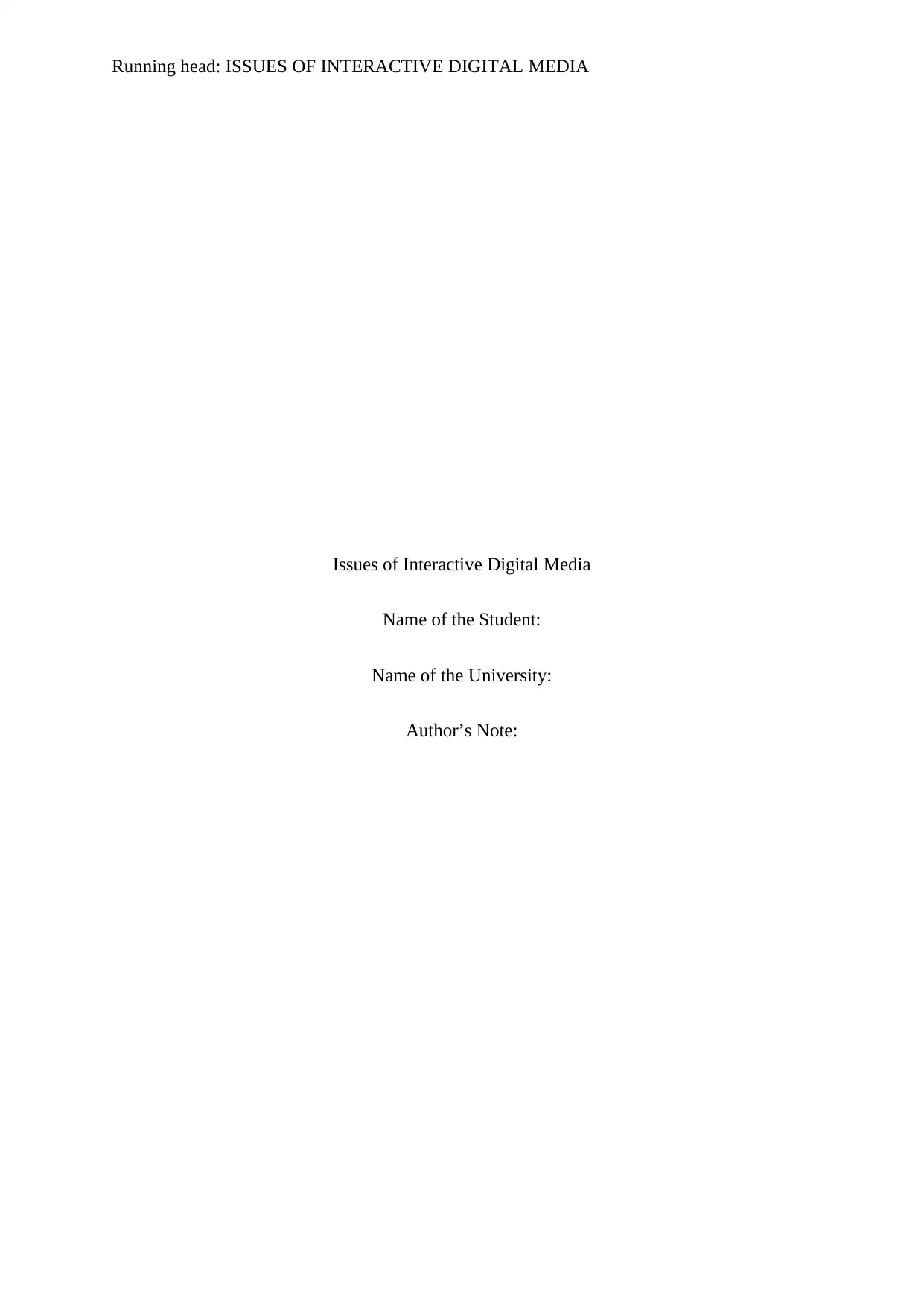
Running head: ISSUES OF INTERACTIVE DIGITAL MEDIA
Issues of Interactive Digital Media
Name of the Student:
Name of the University:
Author’s Note:
Issues of Interactive Digital Media
Name of the Student:
Name of the University:
Author’s Note:
Paraphrase This Document
Need a fresh take? Get an instant paraphrase of this document with our AI Paraphraser
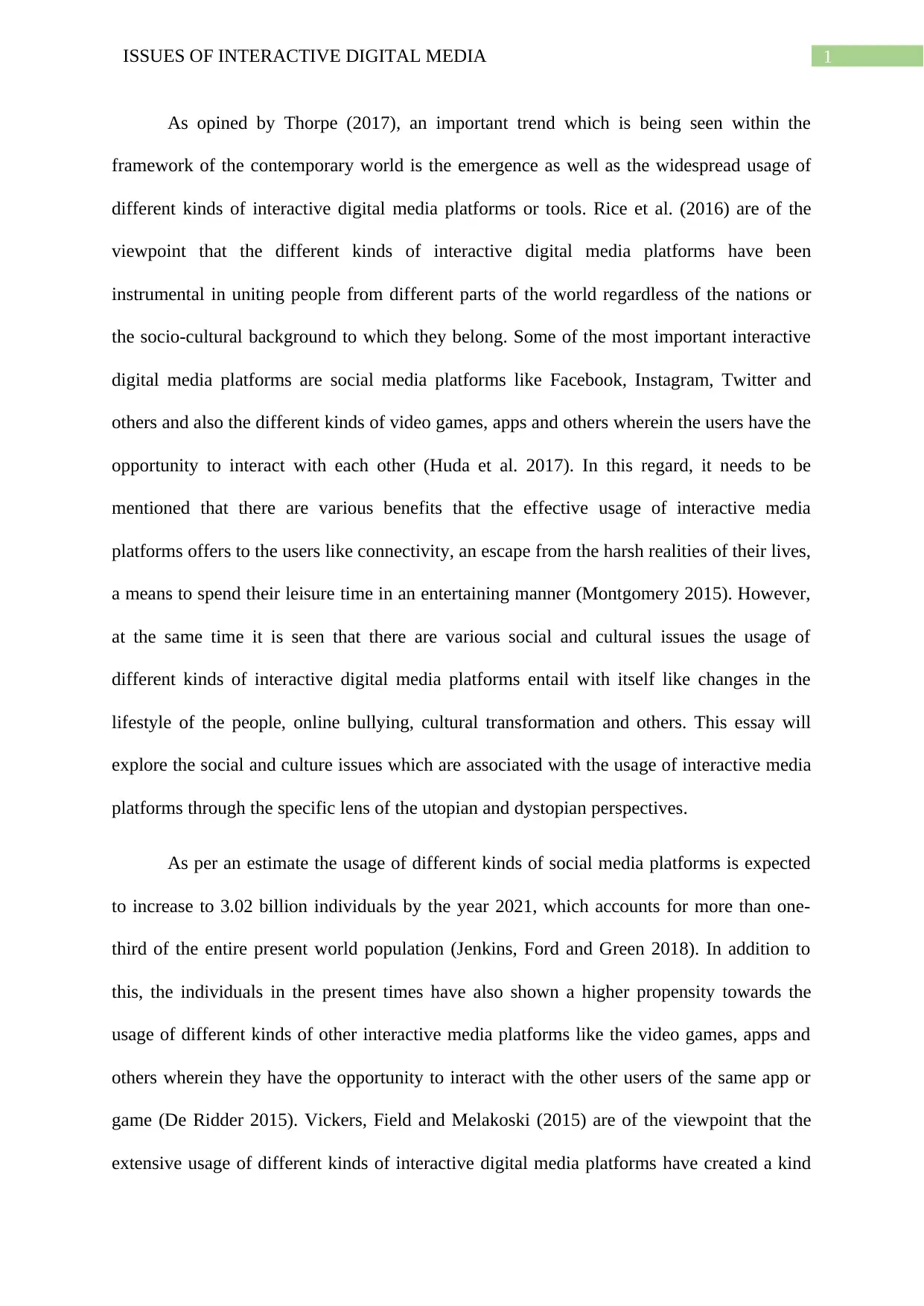
1ISSUES OF INTERACTIVE DIGITAL MEDIA
As opined by Thorpe (2017), an important trend which is being seen within the
framework of the contemporary world is the emergence as well as the widespread usage of
different kinds of interactive digital media platforms or tools. Rice et al. (2016) are of the
viewpoint that the different kinds of interactive digital media platforms have been
instrumental in uniting people from different parts of the world regardless of the nations or
the socio-cultural background to which they belong. Some of the most important interactive
digital media platforms are social media platforms like Facebook, Instagram, Twitter and
others and also the different kinds of video games, apps and others wherein the users have the
opportunity to interact with each other (Huda et al. 2017). In this regard, it needs to be
mentioned that there are various benefits that the effective usage of interactive media
platforms offers to the users like connectivity, an escape from the harsh realities of their lives,
a means to spend their leisure time in an entertaining manner (Montgomery 2015). However,
at the same time it is seen that there are various social and cultural issues the usage of
different kinds of interactive digital media platforms entail with itself like changes in the
lifestyle of the people, online bullying, cultural transformation and others. This essay will
explore the social and culture issues which are associated with the usage of interactive media
platforms through the specific lens of the utopian and dystopian perspectives.
As per an estimate the usage of different kinds of social media platforms is expected
to increase to 3.02 billion individuals by the year 2021, which accounts for more than one-
third of the entire present world population (Jenkins, Ford and Green 2018). In addition to
this, the individuals in the present times have also shown a higher propensity towards the
usage of different kinds of other interactive media platforms like the video games, apps and
others wherein they have the opportunity to interact with the other users of the same app or
game (De Ridder 2015). Vickers, Field and Melakoski (2015) are of the viewpoint that the
extensive usage of different kinds of interactive digital media platforms have created a kind
As opined by Thorpe (2017), an important trend which is being seen within the
framework of the contemporary world is the emergence as well as the widespread usage of
different kinds of interactive digital media platforms or tools. Rice et al. (2016) are of the
viewpoint that the different kinds of interactive digital media platforms have been
instrumental in uniting people from different parts of the world regardless of the nations or
the socio-cultural background to which they belong. Some of the most important interactive
digital media platforms are social media platforms like Facebook, Instagram, Twitter and
others and also the different kinds of video games, apps and others wherein the users have the
opportunity to interact with each other (Huda et al. 2017). In this regard, it needs to be
mentioned that there are various benefits that the effective usage of interactive media
platforms offers to the users like connectivity, an escape from the harsh realities of their lives,
a means to spend their leisure time in an entertaining manner (Montgomery 2015). However,
at the same time it is seen that there are various social and cultural issues the usage of
different kinds of interactive digital media platforms entail with itself like changes in the
lifestyle of the people, online bullying, cultural transformation and others. This essay will
explore the social and culture issues which are associated with the usage of interactive media
platforms through the specific lens of the utopian and dystopian perspectives.
As per an estimate the usage of different kinds of social media platforms is expected
to increase to 3.02 billion individuals by the year 2021, which accounts for more than one-
third of the entire present world population (Jenkins, Ford and Green 2018). In addition to
this, the individuals in the present times have also shown a higher propensity towards the
usage of different kinds of other interactive media platforms like the video games, apps and
others wherein they have the opportunity to interact with the other users of the same app or
game (De Ridder 2015). Vickers, Field and Melakoski (2015) are of the viewpoint that the
extensive usage of different kinds of interactive digital media platforms have created a kind
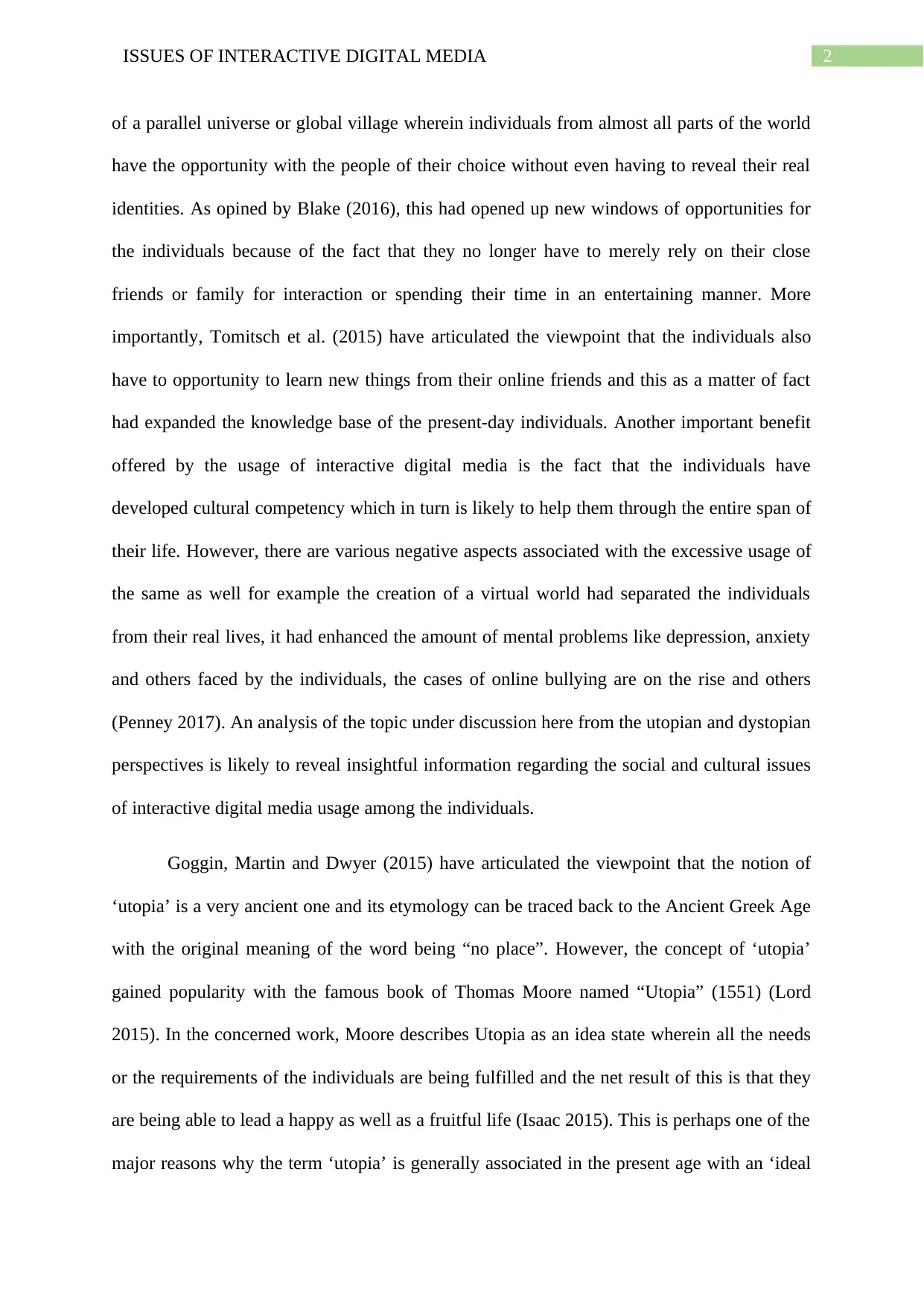
2ISSUES OF INTERACTIVE DIGITAL MEDIA
of a parallel universe or global village wherein individuals from almost all parts of the world
have the opportunity with the people of their choice without even having to reveal their real
identities. As opined by Blake (2016), this had opened up new windows of opportunities for
the individuals because of the fact that they no longer have to merely rely on their close
friends or family for interaction or spending their time in an entertaining manner. More
importantly, Tomitsch et al. (2015) have articulated the viewpoint that the individuals also
have to opportunity to learn new things from their online friends and this as a matter of fact
had expanded the knowledge base of the present-day individuals. Another important benefit
offered by the usage of interactive digital media is the fact that the individuals have
developed cultural competency which in turn is likely to help them through the entire span of
their life. However, there are various negative aspects associated with the excessive usage of
the same as well for example the creation of a virtual world had separated the individuals
from their real lives, it had enhanced the amount of mental problems like depression, anxiety
and others faced by the individuals, the cases of online bullying are on the rise and others
(Penney 2017). An analysis of the topic under discussion here from the utopian and dystopian
perspectives is likely to reveal insightful information regarding the social and cultural issues
of interactive digital media usage among the individuals.
Goggin, Martin and Dwyer (2015) have articulated the viewpoint that the notion of
‘utopia’ is a very ancient one and its etymology can be traced back to the Ancient Greek Age
with the original meaning of the word being “no place”. However, the concept of ‘utopia’
gained popularity with the famous book of Thomas Moore named “Utopia” (1551) (Lord
2015). In the concerned work, Moore describes Utopia as an idea state wherein all the needs
or the requirements of the individuals are being fulfilled and the net result of this is that they
are being able to lead a happy as well as a fruitful life (Isaac 2015). This is perhaps one of the
major reasons why the term ‘utopia’ is generally associated in the present age with an ‘ideal
of a parallel universe or global village wherein individuals from almost all parts of the world
have the opportunity with the people of their choice without even having to reveal their real
identities. As opined by Blake (2016), this had opened up new windows of opportunities for
the individuals because of the fact that they no longer have to merely rely on their close
friends or family for interaction or spending their time in an entertaining manner. More
importantly, Tomitsch et al. (2015) have articulated the viewpoint that the individuals also
have to opportunity to learn new things from their online friends and this as a matter of fact
had expanded the knowledge base of the present-day individuals. Another important benefit
offered by the usage of interactive digital media is the fact that the individuals have
developed cultural competency which in turn is likely to help them through the entire span of
their life. However, there are various negative aspects associated with the excessive usage of
the same as well for example the creation of a virtual world had separated the individuals
from their real lives, it had enhanced the amount of mental problems like depression, anxiety
and others faced by the individuals, the cases of online bullying are on the rise and others
(Penney 2017). An analysis of the topic under discussion here from the utopian and dystopian
perspectives is likely to reveal insightful information regarding the social and cultural issues
of interactive digital media usage among the individuals.
Goggin, Martin and Dwyer (2015) have articulated the viewpoint that the notion of
‘utopia’ is a very ancient one and its etymology can be traced back to the Ancient Greek Age
with the original meaning of the word being “no place”. However, the concept of ‘utopia’
gained popularity with the famous book of Thomas Moore named “Utopia” (1551) (Lord
2015). In the concerned work, Moore describes Utopia as an idea state wherein all the needs
or the requirements of the individuals are being fulfilled and the net result of this is that they
are being able to lead a happy as well as a fruitful life (Isaac 2015). This is perhaps one of the
major reasons why the term ‘utopia’ is generally associated in the present age with an ‘ideal
⊘ This is a preview!⊘
Do you want full access?
Subscribe today to unlock all pages.

Trusted by 1+ million students worldwide
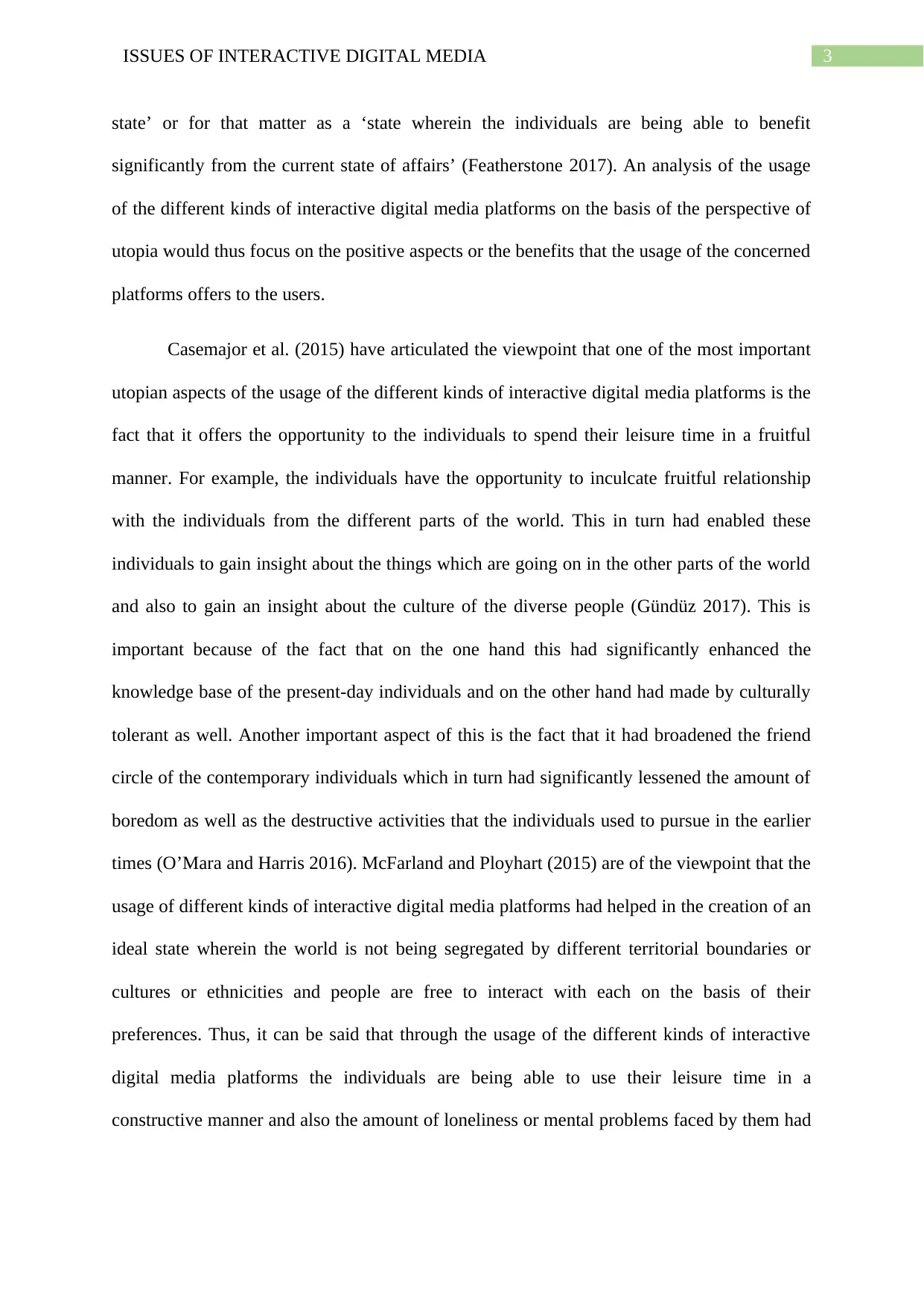
3ISSUES OF INTERACTIVE DIGITAL MEDIA
state’ or for that matter as a ‘state wherein the individuals are being able to benefit
significantly from the current state of affairs’ (Featherstone 2017). An analysis of the usage
of the different kinds of interactive digital media platforms on the basis of the perspective of
utopia would thus focus on the positive aspects or the benefits that the usage of the concerned
platforms offers to the users.
Casemajor et al. (2015) have articulated the viewpoint that one of the most important
utopian aspects of the usage of the different kinds of interactive digital media platforms is the
fact that it offers the opportunity to the individuals to spend their leisure time in a fruitful
manner. For example, the individuals have the opportunity to inculcate fruitful relationship
with the individuals from the different parts of the world. This in turn had enabled these
individuals to gain insight about the things which are going on in the other parts of the world
and also to gain an insight about the culture of the diverse people (Gündüz 2017). This is
important because of the fact that on the one hand this had significantly enhanced the
knowledge base of the present-day individuals and on the other hand had made by culturally
tolerant as well. Another important aspect of this is the fact that it had broadened the friend
circle of the contemporary individuals which in turn had significantly lessened the amount of
boredom as well as the destructive activities that the individuals used to pursue in the earlier
times (O’Mara and Harris 2016). McFarland and Ployhart (2015) are of the viewpoint that the
usage of different kinds of interactive digital media platforms had helped in the creation of an
ideal state wherein the world is not being segregated by different territorial boundaries or
cultures or ethnicities and people are free to interact with each on the basis of their
preferences. Thus, it can be said that through the usage of the different kinds of interactive
digital media platforms the individuals are being able to use their leisure time in a
constructive manner and also the amount of loneliness or mental problems faced by them had
state’ or for that matter as a ‘state wherein the individuals are being able to benefit
significantly from the current state of affairs’ (Featherstone 2017). An analysis of the usage
of the different kinds of interactive digital media platforms on the basis of the perspective of
utopia would thus focus on the positive aspects or the benefits that the usage of the concerned
platforms offers to the users.
Casemajor et al. (2015) have articulated the viewpoint that one of the most important
utopian aspects of the usage of the different kinds of interactive digital media platforms is the
fact that it offers the opportunity to the individuals to spend their leisure time in a fruitful
manner. For example, the individuals have the opportunity to inculcate fruitful relationship
with the individuals from the different parts of the world. This in turn had enabled these
individuals to gain insight about the things which are going on in the other parts of the world
and also to gain an insight about the culture of the diverse people (Gündüz 2017). This is
important because of the fact that on the one hand this had significantly enhanced the
knowledge base of the present-day individuals and on the other hand had made by culturally
tolerant as well. Another important aspect of this is the fact that it had broadened the friend
circle of the contemporary individuals which in turn had significantly lessened the amount of
boredom as well as the destructive activities that the individuals used to pursue in the earlier
times (O’Mara and Harris 2016). McFarland and Ployhart (2015) are of the viewpoint that the
usage of different kinds of interactive digital media platforms had helped in the creation of an
ideal state wherein the world is not being segregated by different territorial boundaries or
cultures or ethnicities and people are free to interact with each on the basis of their
preferences. Thus, it can be said that through the usage of the different kinds of interactive
digital media platforms the individuals are being able to use their leisure time in a
constructive manner and also the amount of loneliness or mental problems faced by them had
Paraphrase This Document
Need a fresh take? Get an instant paraphrase of this document with our AI Paraphraser
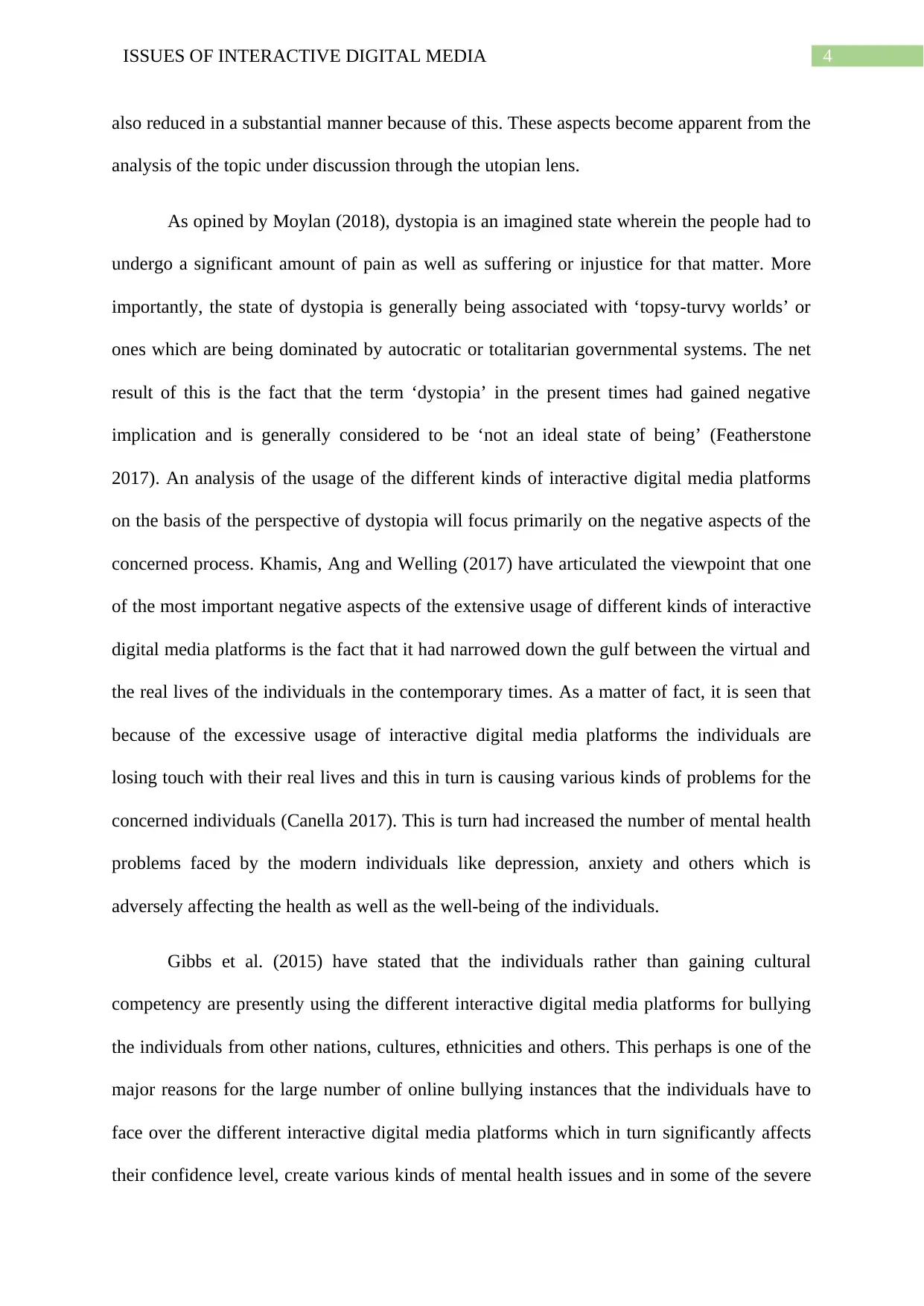
4ISSUES OF INTERACTIVE DIGITAL MEDIA
also reduced in a substantial manner because of this. These aspects become apparent from the
analysis of the topic under discussion through the utopian lens.
As opined by Moylan (2018), dystopia is an imagined state wherein the people had to
undergo a significant amount of pain as well as suffering or injustice for that matter. More
importantly, the state of dystopia is generally being associated with ‘topsy-turvy worlds’ or
ones which are being dominated by autocratic or totalitarian governmental systems. The net
result of this is the fact that the term ‘dystopia’ in the present times had gained negative
implication and is generally considered to be ‘not an ideal state of being’ (Featherstone
2017). An analysis of the usage of the different kinds of interactive digital media platforms
on the basis of the perspective of dystopia will focus primarily on the negative aspects of the
concerned process. Khamis, Ang and Welling (2017) have articulated the viewpoint that one
of the most important negative aspects of the extensive usage of different kinds of interactive
digital media platforms is the fact that it had narrowed down the gulf between the virtual and
the real lives of the individuals in the contemporary times. As a matter of fact, it is seen that
because of the excessive usage of interactive digital media platforms the individuals are
losing touch with their real lives and this in turn is causing various kinds of problems for the
concerned individuals (Canella 2017). This is turn had increased the number of mental health
problems faced by the modern individuals like depression, anxiety and others which is
adversely affecting the health as well as the well-being of the individuals.
Gibbs et al. (2015) have stated that the individuals rather than gaining cultural
competency are presently using the different interactive digital media platforms for bullying
the individuals from other nations, cultures, ethnicities and others. This perhaps is one of the
major reasons for the large number of online bullying instances that the individuals have to
face over the different interactive digital media platforms which in turn significantly affects
their confidence level, create various kinds of mental health issues and in some of the severe
also reduced in a substantial manner because of this. These aspects become apparent from the
analysis of the topic under discussion through the utopian lens.
As opined by Moylan (2018), dystopia is an imagined state wherein the people had to
undergo a significant amount of pain as well as suffering or injustice for that matter. More
importantly, the state of dystopia is generally being associated with ‘topsy-turvy worlds’ or
ones which are being dominated by autocratic or totalitarian governmental systems. The net
result of this is the fact that the term ‘dystopia’ in the present times had gained negative
implication and is generally considered to be ‘not an ideal state of being’ (Featherstone
2017). An analysis of the usage of the different kinds of interactive digital media platforms
on the basis of the perspective of dystopia will focus primarily on the negative aspects of the
concerned process. Khamis, Ang and Welling (2017) have articulated the viewpoint that one
of the most important negative aspects of the extensive usage of different kinds of interactive
digital media platforms is the fact that it had narrowed down the gulf between the virtual and
the real lives of the individuals in the contemporary times. As a matter of fact, it is seen that
because of the excessive usage of interactive digital media platforms the individuals are
losing touch with their real lives and this in turn is causing various kinds of problems for the
concerned individuals (Canella 2017). This is turn had increased the number of mental health
problems faced by the modern individuals like depression, anxiety and others which is
adversely affecting the health as well as the well-being of the individuals.
Gibbs et al. (2015) have stated that the individuals rather than gaining cultural
competency are presently using the different interactive digital media platforms for bullying
the individuals from other nations, cultures, ethnicities and others. This perhaps is one of the
major reasons for the large number of online bullying instances that the individuals have to
face over the different interactive digital media platforms which in turn significantly affects
their confidence level, create various kinds of mental health issues and in some of the severe
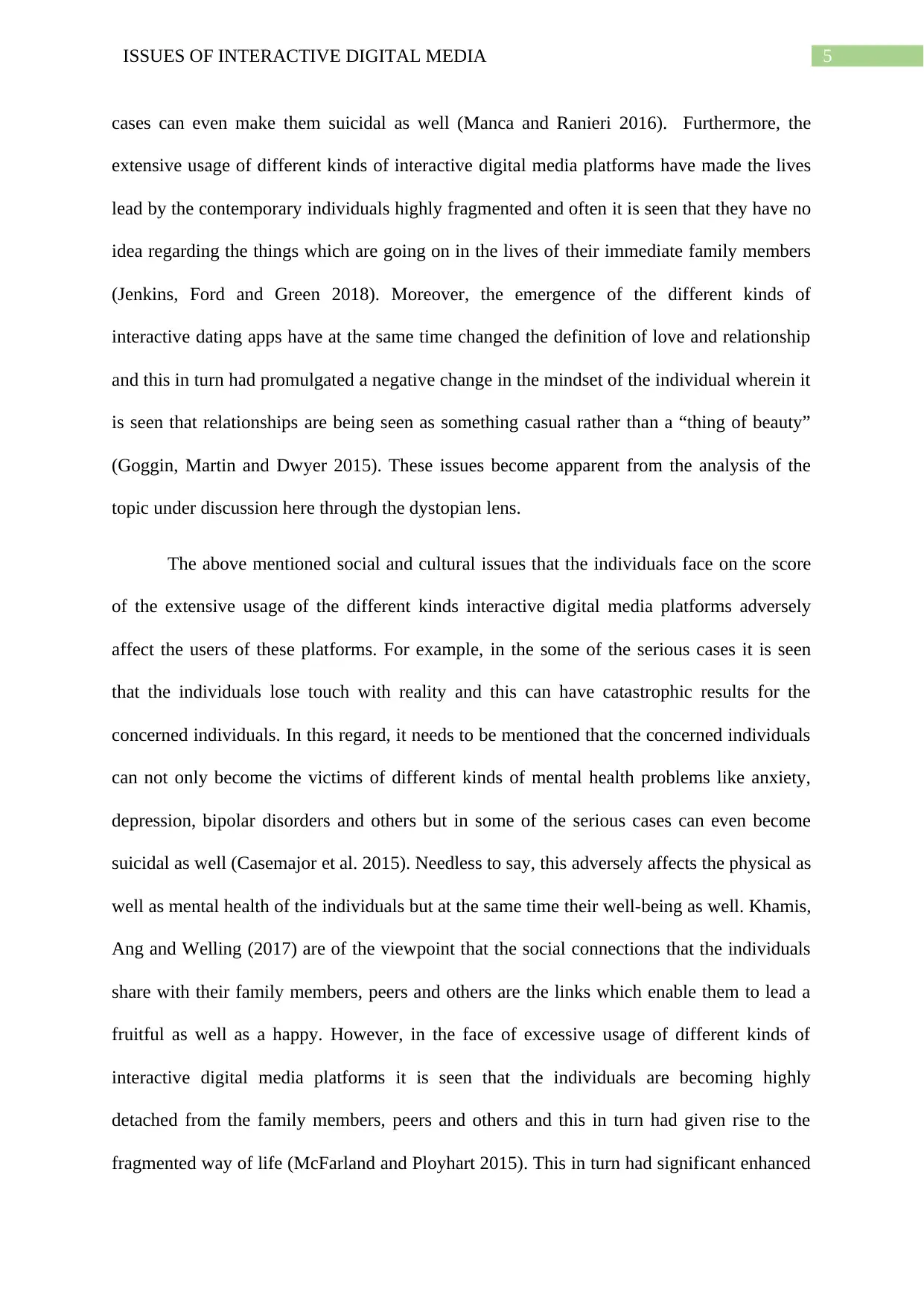
5ISSUES OF INTERACTIVE DIGITAL MEDIA
cases can even make them suicidal as well (Manca and Ranieri 2016). Furthermore, the
extensive usage of different kinds of interactive digital media platforms have made the lives
lead by the contemporary individuals highly fragmented and often it is seen that they have no
idea regarding the things which are going on in the lives of their immediate family members
(Jenkins, Ford and Green 2018). Moreover, the emergence of the different kinds of
interactive dating apps have at the same time changed the definition of love and relationship
and this in turn had promulgated a negative change in the mindset of the individual wherein it
is seen that relationships are being seen as something casual rather than a “thing of beauty”
(Goggin, Martin and Dwyer 2015). These issues become apparent from the analysis of the
topic under discussion here through the dystopian lens.
The above mentioned social and cultural issues that the individuals face on the score
of the extensive usage of the different kinds interactive digital media platforms adversely
affect the users of these platforms. For example, in the some of the serious cases it is seen
that the individuals lose touch with reality and this can have catastrophic results for the
concerned individuals. In this regard, it needs to be mentioned that the concerned individuals
can not only become the victims of different kinds of mental health problems like anxiety,
depression, bipolar disorders and others but in some of the serious cases can even become
suicidal as well (Casemajor et al. 2015). Needless to say, this adversely affects the physical as
well as mental health of the individuals but at the same time their well-being as well. Khamis,
Ang and Welling (2017) are of the viewpoint that the social connections that the individuals
share with their family members, peers and others are the links which enable them to lead a
fruitful as well as a happy. However, in the face of excessive usage of different kinds of
interactive digital media platforms it is seen that the individuals are becoming highly
detached from the family members, peers and others and this in turn had given rise to the
fragmented way of life (McFarland and Ployhart 2015). This in turn had significant enhanced
cases can even make them suicidal as well (Manca and Ranieri 2016). Furthermore, the
extensive usage of different kinds of interactive digital media platforms have made the lives
lead by the contemporary individuals highly fragmented and often it is seen that they have no
idea regarding the things which are going on in the lives of their immediate family members
(Jenkins, Ford and Green 2018). Moreover, the emergence of the different kinds of
interactive dating apps have at the same time changed the definition of love and relationship
and this in turn had promulgated a negative change in the mindset of the individual wherein it
is seen that relationships are being seen as something casual rather than a “thing of beauty”
(Goggin, Martin and Dwyer 2015). These issues become apparent from the analysis of the
topic under discussion here through the dystopian lens.
The above mentioned social and cultural issues that the individuals face on the score
of the extensive usage of the different kinds interactive digital media platforms adversely
affect the users of these platforms. For example, in the some of the serious cases it is seen
that the individuals lose touch with reality and this can have catastrophic results for the
concerned individuals. In this regard, it needs to be mentioned that the concerned individuals
can not only become the victims of different kinds of mental health problems like anxiety,
depression, bipolar disorders and others but in some of the serious cases can even become
suicidal as well (Casemajor et al. 2015). Needless to say, this adversely affects the physical as
well as mental health of the individuals but at the same time their well-being as well. Khamis,
Ang and Welling (2017) are of the viewpoint that the social connections that the individuals
share with their family members, peers and others are the links which enable them to lead a
fruitful as well as a happy. However, in the face of excessive usage of different kinds of
interactive digital media platforms it is seen that the individuals are becoming highly
detached from the family members, peers and others and this in turn had given rise to the
fragmented way of life (McFarland and Ployhart 2015). This in turn had significant enhanced
⊘ This is a preview!⊘
Do you want full access?
Subscribe today to unlock all pages.

Trusted by 1+ million students worldwide
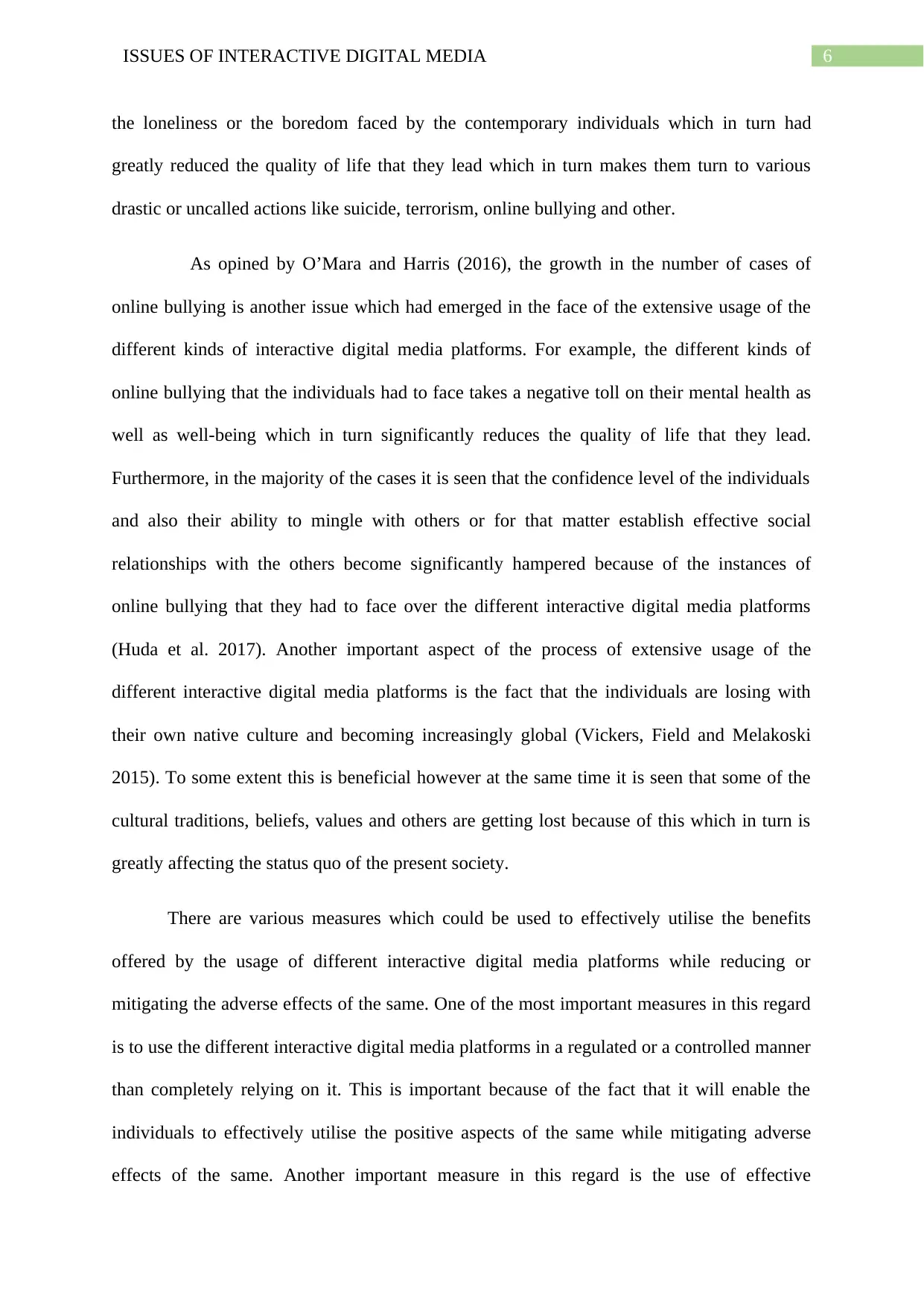
6ISSUES OF INTERACTIVE DIGITAL MEDIA
the loneliness or the boredom faced by the contemporary individuals which in turn had
greatly reduced the quality of life that they lead which in turn makes them turn to various
drastic or uncalled actions like suicide, terrorism, online bullying and other.
As opined by O’Mara and Harris (2016), the growth in the number of cases of
online bullying is another issue which had emerged in the face of the extensive usage of the
different kinds of interactive digital media platforms. For example, the different kinds of
online bullying that the individuals had to face takes a negative toll on their mental health as
well as well-being which in turn significantly reduces the quality of life that they lead.
Furthermore, in the majority of the cases it is seen that the confidence level of the individuals
and also their ability to mingle with others or for that matter establish effective social
relationships with the others become significantly hampered because of the instances of
online bullying that they had to face over the different interactive digital media platforms
(Huda et al. 2017). Another important aspect of the process of extensive usage of the
different interactive digital media platforms is the fact that the individuals are losing with
their own native culture and becoming increasingly global (Vickers, Field and Melakoski
2015). To some extent this is beneficial however at the same time it is seen that some of the
cultural traditions, beliefs, values and others are getting lost because of this which in turn is
greatly affecting the status quo of the present society.
There are various measures which could be used to effectively utilise the benefits
offered by the usage of different interactive digital media platforms while reducing or
mitigating the adverse effects of the same. One of the most important measures in this regard
is to use the different interactive digital media platforms in a regulated or a controlled manner
than completely relying on it. This is important because of the fact that it will enable the
individuals to effectively utilise the positive aspects of the same while mitigating adverse
effects of the same. Another important measure in this regard is the use of effective
the loneliness or the boredom faced by the contemporary individuals which in turn had
greatly reduced the quality of life that they lead which in turn makes them turn to various
drastic or uncalled actions like suicide, terrorism, online bullying and other.
As opined by O’Mara and Harris (2016), the growth in the number of cases of
online bullying is another issue which had emerged in the face of the extensive usage of the
different kinds of interactive digital media platforms. For example, the different kinds of
online bullying that the individuals had to face takes a negative toll on their mental health as
well as well-being which in turn significantly reduces the quality of life that they lead.
Furthermore, in the majority of the cases it is seen that the confidence level of the individuals
and also their ability to mingle with others or for that matter establish effective social
relationships with the others become significantly hampered because of the instances of
online bullying that they had to face over the different interactive digital media platforms
(Huda et al. 2017). Another important aspect of the process of extensive usage of the
different interactive digital media platforms is the fact that the individuals are losing with
their own native culture and becoming increasingly global (Vickers, Field and Melakoski
2015). To some extent this is beneficial however at the same time it is seen that some of the
cultural traditions, beliefs, values and others are getting lost because of this which in turn is
greatly affecting the status quo of the present society.
There are various measures which could be used to effectively utilise the benefits
offered by the usage of different interactive digital media platforms while reducing or
mitigating the adverse effects of the same. One of the most important measures in this regard
is to use the different interactive digital media platforms in a regulated or a controlled manner
than completely relying on it. This is important because of the fact that it will enable the
individuals to effectively utilise the positive aspects of the same while mitigating adverse
effects of the same. Another important measure in this regard is the use of effective
Paraphrase This Document
Need a fresh take? Get an instant paraphrase of this document with our AI Paraphraser
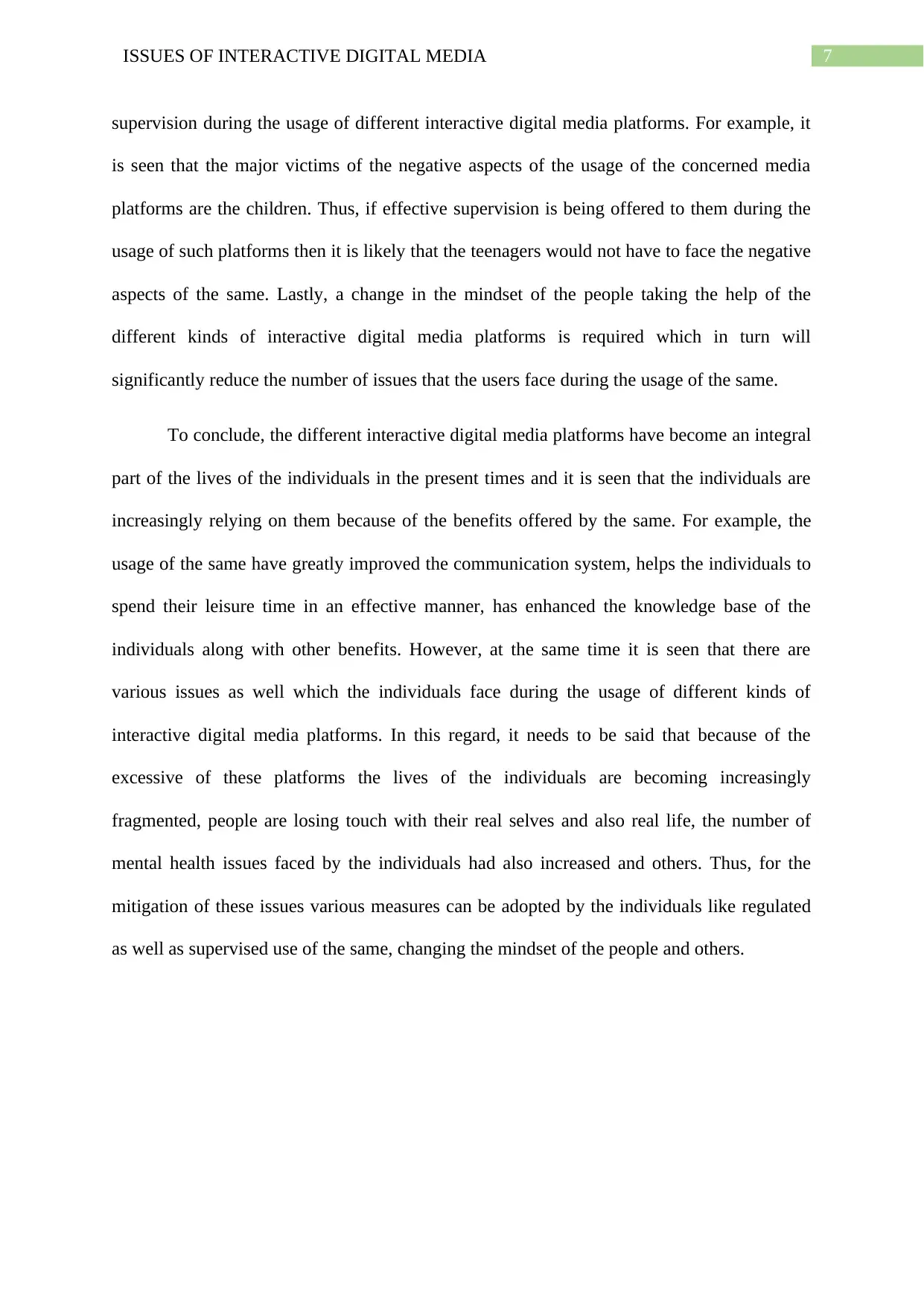
7ISSUES OF INTERACTIVE DIGITAL MEDIA
supervision during the usage of different interactive digital media platforms. For example, it
is seen that the major victims of the negative aspects of the usage of the concerned media
platforms are the children. Thus, if effective supervision is being offered to them during the
usage of such platforms then it is likely that the teenagers would not have to face the negative
aspects of the same. Lastly, a change in the mindset of the people taking the help of the
different kinds of interactive digital media platforms is required which in turn will
significantly reduce the number of issues that the users face during the usage of the same.
To conclude, the different interactive digital media platforms have become an integral
part of the lives of the individuals in the present times and it is seen that the individuals are
increasingly relying on them because of the benefits offered by the same. For example, the
usage of the same have greatly improved the communication system, helps the individuals to
spend their leisure time in an effective manner, has enhanced the knowledge base of the
individuals along with other benefits. However, at the same time it is seen that there are
various issues as well which the individuals face during the usage of different kinds of
interactive digital media platforms. In this regard, it needs to be said that because of the
excessive of these platforms the lives of the individuals are becoming increasingly
fragmented, people are losing touch with their real selves and also real life, the number of
mental health issues faced by the individuals had also increased and others. Thus, for the
mitigation of these issues various measures can be adopted by the individuals like regulated
as well as supervised use of the same, changing the mindset of the people and others.
supervision during the usage of different interactive digital media platforms. For example, it
is seen that the major victims of the negative aspects of the usage of the concerned media
platforms are the children. Thus, if effective supervision is being offered to them during the
usage of such platforms then it is likely that the teenagers would not have to face the negative
aspects of the same. Lastly, a change in the mindset of the people taking the help of the
different kinds of interactive digital media platforms is required which in turn will
significantly reduce the number of issues that the users face during the usage of the same.
To conclude, the different interactive digital media platforms have become an integral
part of the lives of the individuals in the present times and it is seen that the individuals are
increasingly relying on them because of the benefits offered by the same. For example, the
usage of the same have greatly improved the communication system, helps the individuals to
spend their leisure time in an effective manner, has enhanced the knowledge base of the
individuals along with other benefits. However, at the same time it is seen that there are
various issues as well which the individuals face during the usage of different kinds of
interactive digital media platforms. In this regard, it needs to be said that because of the
excessive of these platforms the lives of the individuals are becoming increasingly
fragmented, people are losing touch with their real selves and also real life, the number of
mental health issues faced by the individuals had also increased and others. Thus, for the
mitigation of these issues various measures can be adopted by the individuals like regulated
as well as supervised use of the same, changing the mindset of the people and others.
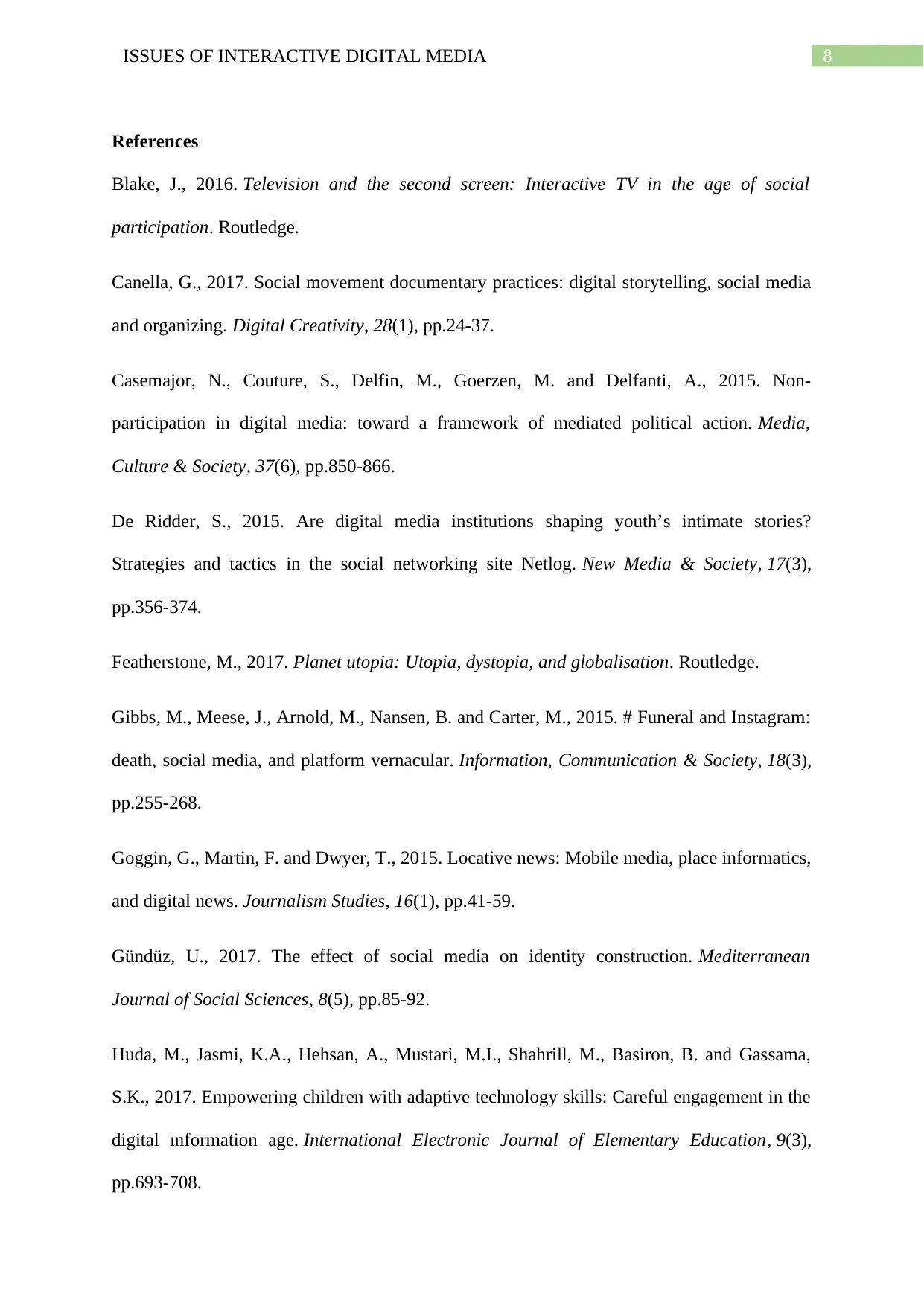
8ISSUES OF INTERACTIVE DIGITAL MEDIA
References
Blake, J., 2016. Television and the second screen: Interactive TV in the age of social
participation. Routledge.
Canella, G., 2017. Social movement documentary practices: digital storytelling, social media
and organizing. Digital Creativity, 28(1), pp.24-37.
Casemajor, N., Couture, S., Delfin, M., Goerzen, M. and Delfanti, A., 2015. Non-
participation in digital media: toward a framework of mediated political action. Media,
Culture & Society, 37(6), pp.850-866.
De Ridder, S., 2015. Are digital media institutions shaping youth’s intimate stories?
Strategies and tactics in the social networking site Netlog. New Media & Society, 17(3),
pp.356-374.
Featherstone, M., 2017. Planet utopia: Utopia, dystopia, and globalisation. Routledge.
Gibbs, M., Meese, J., Arnold, M., Nansen, B. and Carter, M., 2015. # Funeral and Instagram:
death, social media, and platform vernacular. Information, Communication & Society, 18(3),
pp.255-268.
Goggin, G., Martin, F. and Dwyer, T., 2015. Locative news: Mobile media, place informatics,
and digital news. Journalism Studies, 16(1), pp.41-59.
Gündüz, U., 2017. The effect of social media on identity construction. Mediterranean
Journal of Social Sciences, 8(5), pp.85-92.
Huda, M., Jasmi, K.A., Hehsan, A., Mustari, M.I., Shahrill, M., Basiron, B. and Gassama,
S.K., 2017. Empowering children with adaptive technology skills: Careful engagement in the
digital ınformation age. International Electronic Journal of Elementary Education, 9(3),
pp.693-708.
References
Blake, J., 2016. Television and the second screen: Interactive TV in the age of social
participation. Routledge.
Canella, G., 2017. Social movement documentary practices: digital storytelling, social media
and organizing. Digital Creativity, 28(1), pp.24-37.
Casemajor, N., Couture, S., Delfin, M., Goerzen, M. and Delfanti, A., 2015. Non-
participation in digital media: toward a framework of mediated political action. Media,
Culture & Society, 37(6), pp.850-866.
De Ridder, S., 2015. Are digital media institutions shaping youth’s intimate stories?
Strategies and tactics in the social networking site Netlog. New Media & Society, 17(3),
pp.356-374.
Featherstone, M., 2017. Planet utopia: Utopia, dystopia, and globalisation. Routledge.
Gibbs, M., Meese, J., Arnold, M., Nansen, B. and Carter, M., 2015. # Funeral and Instagram:
death, social media, and platform vernacular. Information, Communication & Society, 18(3),
pp.255-268.
Goggin, G., Martin, F. and Dwyer, T., 2015. Locative news: Mobile media, place informatics,
and digital news. Journalism Studies, 16(1), pp.41-59.
Gündüz, U., 2017. The effect of social media on identity construction. Mediterranean
Journal of Social Sciences, 8(5), pp.85-92.
Huda, M., Jasmi, K.A., Hehsan, A., Mustari, M.I., Shahrill, M., Basiron, B. and Gassama,
S.K., 2017. Empowering children with adaptive technology skills: Careful engagement in the
digital ınformation age. International Electronic Journal of Elementary Education, 9(3),
pp.693-708.
⊘ This is a preview!⊘
Do you want full access?
Subscribe today to unlock all pages.

Trusted by 1+ million students worldwide
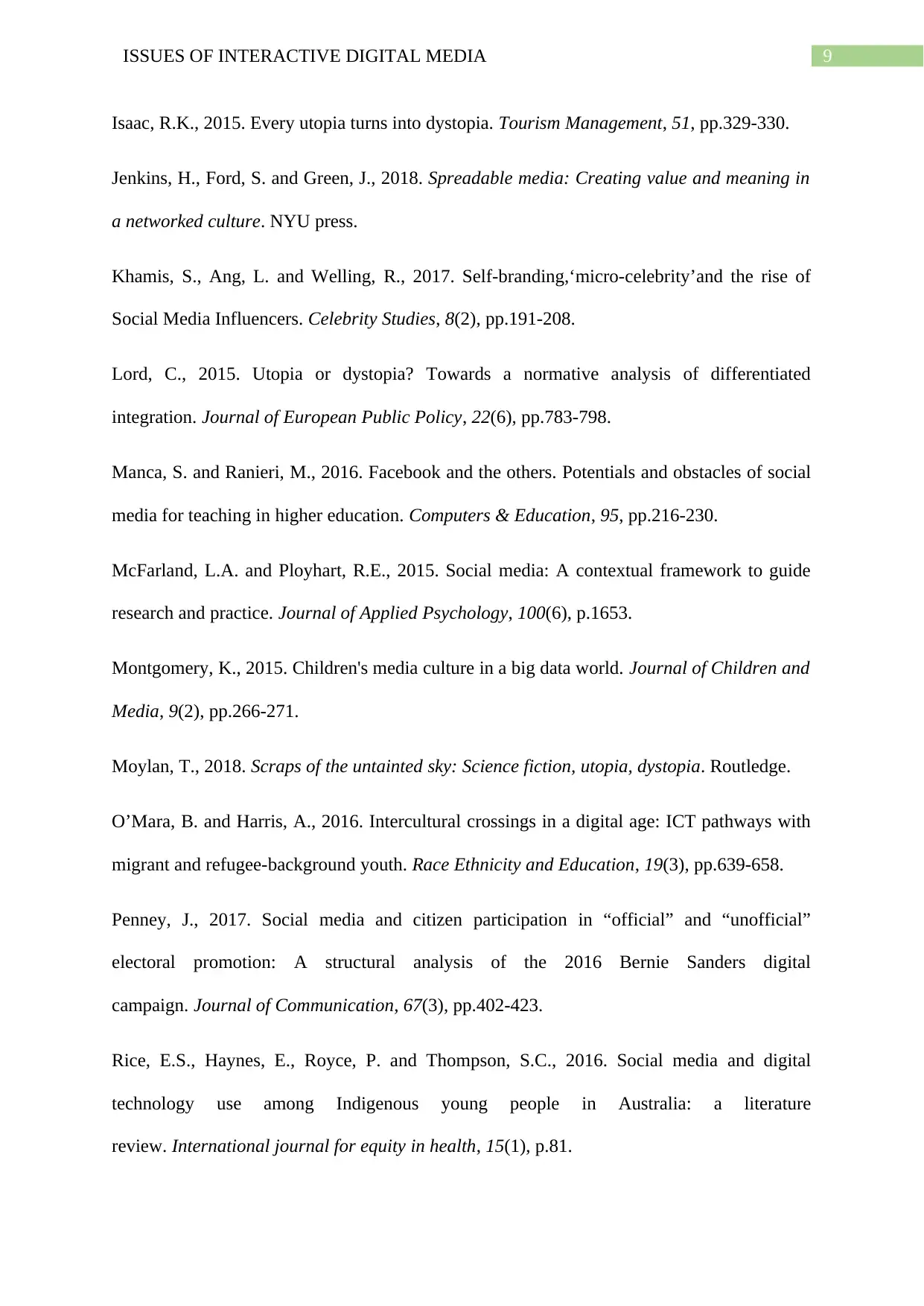
9ISSUES OF INTERACTIVE DIGITAL MEDIA
Isaac, R.K., 2015. Every utopia turns into dystopia. Tourism Management, 51, pp.329-330.
Jenkins, H., Ford, S. and Green, J., 2018. Spreadable media: Creating value and meaning in
a networked culture. NYU press.
Khamis, S., Ang, L. and Welling, R., 2017. Self-branding,‘micro-celebrity’and the rise of
Social Media Influencers. Celebrity Studies, 8(2), pp.191-208.
Lord, C., 2015. Utopia or dystopia? Towards a normative analysis of differentiated
integration. Journal of European Public Policy, 22(6), pp.783-798.
Manca, S. and Ranieri, M., 2016. Facebook and the others. Potentials and obstacles of social
media for teaching in higher education. Computers & Education, 95, pp.216-230.
McFarland, L.A. and Ployhart, R.E., 2015. Social media: A contextual framework to guide
research and practice. Journal of Applied Psychology, 100(6), p.1653.
Montgomery, K., 2015. Children's media culture in a big data world. Journal of Children and
Media, 9(2), pp.266-271.
Moylan, T., 2018. Scraps of the untainted sky: Science fiction, utopia, dystopia. Routledge.
O’Mara, B. and Harris, A., 2016. Intercultural crossings in a digital age: ICT pathways with
migrant and refugee-background youth. Race Ethnicity and Education, 19(3), pp.639-658.
Penney, J., 2017. Social media and citizen participation in “official” and “unofficial”
electoral promotion: A structural analysis of the 2016 Bernie Sanders digital
campaign. Journal of Communication, 67(3), pp.402-423.
Rice, E.S., Haynes, E., Royce, P. and Thompson, S.C., 2016. Social media and digital
technology use among Indigenous young people in Australia: a literature
review. International journal for equity in health, 15(1), p.81.
Isaac, R.K., 2015. Every utopia turns into dystopia. Tourism Management, 51, pp.329-330.
Jenkins, H., Ford, S. and Green, J., 2018. Spreadable media: Creating value and meaning in
a networked culture. NYU press.
Khamis, S., Ang, L. and Welling, R., 2017. Self-branding,‘micro-celebrity’and the rise of
Social Media Influencers. Celebrity Studies, 8(2), pp.191-208.
Lord, C., 2015. Utopia or dystopia? Towards a normative analysis of differentiated
integration. Journal of European Public Policy, 22(6), pp.783-798.
Manca, S. and Ranieri, M., 2016. Facebook and the others. Potentials and obstacles of social
media for teaching in higher education. Computers & Education, 95, pp.216-230.
McFarland, L.A. and Ployhart, R.E., 2015. Social media: A contextual framework to guide
research and practice. Journal of Applied Psychology, 100(6), p.1653.
Montgomery, K., 2015. Children's media culture in a big data world. Journal of Children and
Media, 9(2), pp.266-271.
Moylan, T., 2018. Scraps of the untainted sky: Science fiction, utopia, dystopia. Routledge.
O’Mara, B. and Harris, A., 2016. Intercultural crossings in a digital age: ICT pathways with
migrant and refugee-background youth. Race Ethnicity and Education, 19(3), pp.639-658.
Penney, J., 2017. Social media and citizen participation in “official” and “unofficial”
electoral promotion: A structural analysis of the 2016 Bernie Sanders digital
campaign. Journal of Communication, 67(3), pp.402-423.
Rice, E.S., Haynes, E., Royce, P. and Thompson, S.C., 2016. Social media and digital
technology use among Indigenous young people in Australia: a literature
review. International journal for equity in health, 15(1), p.81.
Paraphrase This Document
Need a fresh take? Get an instant paraphrase of this document with our AI Paraphraser
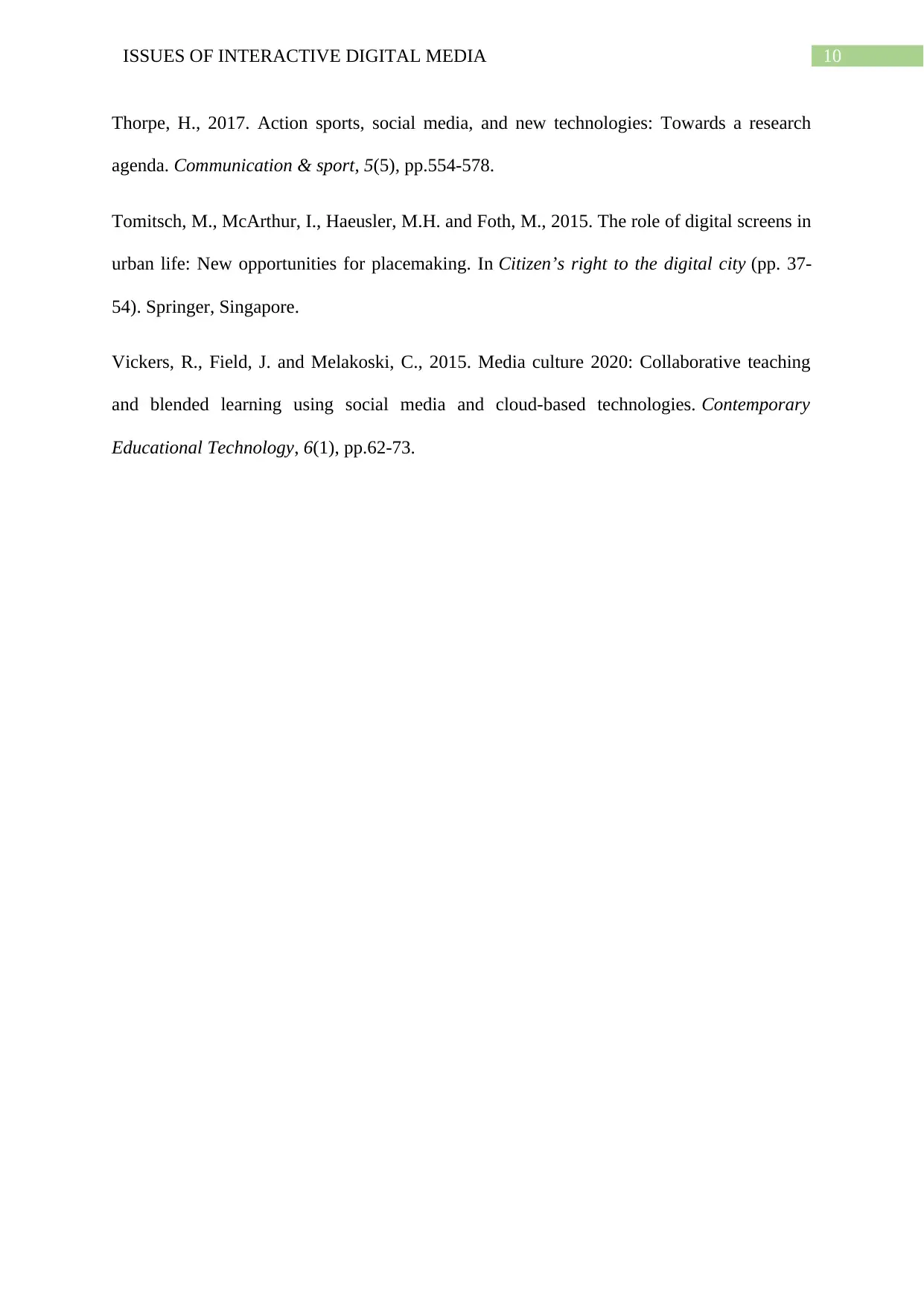
10ISSUES OF INTERACTIVE DIGITAL MEDIA
Thorpe, H., 2017. Action sports, social media, and new technologies: Towards a research
agenda. Communication & sport, 5(5), pp.554-578.
Tomitsch, M., McArthur, I., Haeusler, M.H. and Foth, M., 2015. The role of digital screens in
urban life: New opportunities for placemaking. In Citizen’s right to the digital city (pp. 37-
54). Springer, Singapore.
Vickers, R., Field, J. and Melakoski, C., 2015. Media culture 2020: Collaborative teaching
and blended learning using social media and cloud-based technologies. Contemporary
Educational Technology, 6(1), pp.62-73.
Thorpe, H., 2017. Action sports, social media, and new technologies: Towards a research
agenda. Communication & sport, 5(5), pp.554-578.
Tomitsch, M., McArthur, I., Haeusler, M.H. and Foth, M., 2015. The role of digital screens in
urban life: New opportunities for placemaking. In Citizen’s right to the digital city (pp. 37-
54). Springer, Singapore.
Vickers, R., Field, J. and Melakoski, C., 2015. Media culture 2020: Collaborative teaching
and blended learning using social media and cloud-based technologies. Contemporary
Educational Technology, 6(1), pp.62-73.
1 out of 11
Related Documents
Your All-in-One AI-Powered Toolkit for Academic Success.
+13062052269
info@desklib.com
Available 24*7 on WhatsApp / Email
![[object Object]](/_next/static/media/star-bottom.7253800d.svg)
Unlock your academic potential
Copyright © 2020–2025 A2Z Services. All Rights Reserved. Developed and managed by ZUCOL.




